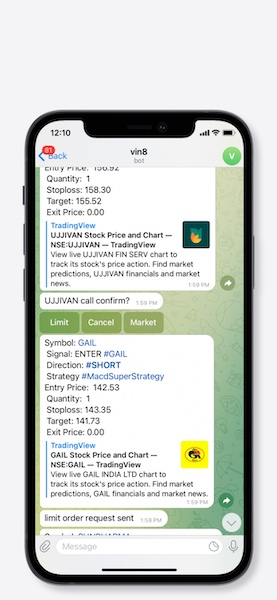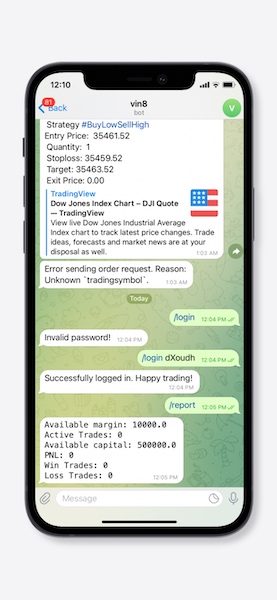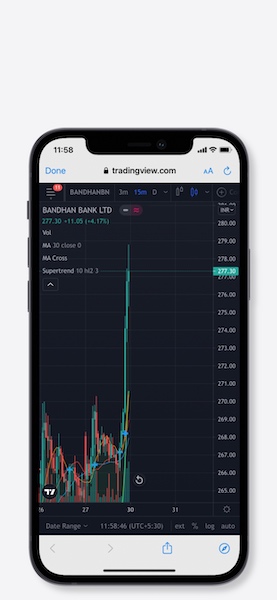>_• Kinetick Trade Bot




Kinetick is a framework for creating and running trading strategies without worrying about integration with broker and data streams (currently integrates with zerodha [*]). Kinetick is aimed to make systematic trading available for everyone.
Leave the heavy lifting to kinetick so that you can focus on building strategies.
 |
 |
 |
- A continuously-running Blotter that lets you capture market data even when your algos aren't running.
- Tick, Bar and Trade data is stored in MongoDB for later analysis and backtesting.
- Using pub/sub architecture using ØMQ (ZeroMQ) for communicating between the Algo and the Blotter allows for a single Blotter/multiple Algos running on the same machine.
- Support for Order Book, Quote, Time, Tick or Volume based strategy resolutions.
- Includes many common indicators that you can seamlessly use in your algorithm.
- Market data events use asynchronous, non-blocking architecture.
- Realtime alerts and order confirmation delivered to your mobile via Telegram bot (requires a Telegram bot token).
- Full integration with TA-Lib via dedicated module (see example).
- Ability to import any Python library (such as scikit-learn or TensorFlow) to use them in your algorithms.
- Live charts powered by TradingView
- RiskAssessor to manage and limit the risk even if strategy goes unexpected
- Power packed batteries included
- Deploy wherever Docker lives
Install using pip:
$ pip install kinetickThere are 5 main components in Kinetick:
Bot- sends alert and signals with actions to perform.Blotter- handles market data retrieval and processing.Broker- sends and process orders/positions (abstracted layer).Algo- (sub-class ofBroker) communicates with theBlotterto pass market data to your strategies, and process/positions orders viaBroker.- Lastly, Your Strategies, which are sub-classes of
Algo, handle the trading logic/rules. This is where you'll write most of your code.
To get started, you need to first create a Blotter script:
# blotter.py
from kinetick.blotter import Blotter
class MainBlotter(Blotter):
pass # we just need the name
if __name__ == "__main__":
blotter = MainBlotter()
blotter.run()Then run the Blotter from the command line:
$ python -m blotterIf your strategy needs order book / market depth data, add the --orderbook flag to the command:
$ python -m blotter --orderbookWhile the Blotter running in the background, write and execute your algorithm:
# strategy.py
from kinetick.algo import Algo
class CrossOver(Algo):
def on_start(self):
pass
def on_fill(self, instrument, order):
pass
def on_quote(self, instrument):
pass
def on_orderbook(self, instrument):
pass
def on_tick(self, instrument):
pass
def on_bar(self, instrument):
# get instrument history
bars = instrument.get_bars(window=100)
# or get all instruments history
# bars = self.bars[-20:]
# skip first 20 days to get full windows
if len(bars) < 20:
return
# compute averages using internal rolling_mean
bars['short_ma'] = bars['close'].rolling(window=10).mean()
bars['long_ma'] = bars['close'].rolling(window=20).mean()
# get current position data
positions = instrument.get_positions()
# trading logic - entry signal
if bars['short_ma'].crossed_above(bars['long_ma'])[-1]:
if not instrument.pending_orders and positions["position"] == 0:
""" buy one contract.
WARNING: buy or order instrument methods will bypass bot and risk assessor.
Instead, It is advised to use create_position, open_position and close_position instrument methods
to route the order via bot and risk assessor. """
instrument.buy(1)
# record values for later analysis
self.record(ma_cross=1)
# trading logic - exit signal
elif bars['short_ma'].crossed_below(bars['long_ma'])[-1]:
if positions["position"] != 0:
# exit / flatten position
instrument.exit()
# record values for later analysis
self.record(ma_cross=-1)
if __name__ == "__main__":
strategy = CrossOver(
instruments = ['ACC', 'SBIN'], # scrip symbols
resolution = "1T", # Pandas resolution (use "K" for tick bars)
tick_window = 20, # no. of ticks to keep
bar_window = 5, # no. of bars to keep
preload = "1D", # preload 1 day history when starting
timezone = "Asia/Calcutta" # convert all ticks/bars to this timezone
)
strategy.run()To run your algo in a live environment, from the command line, type:
$ python -m strategy --logpath ~/ordersThe resulting trades be saved in ~/orders/STRATEGY_YYYYMMDD.csv for later analysis.
While the Strategy running in the background:
Assuming you have added the telegram bot to your chat
/login <password>- password can be found in the strategy console.
/report- get overview about trades/help- get help/resetrms- resets RiskAssessor parameters to its initial values.
Can be specified either as env variable or cmdline arg
| Parameter | Required? | Example | Default | Description |
symbols |
symbols=./symbols.csv | |||
LOGLEVEL |
LOGLEVEL=DEBUG | INFO | ||
zerodha_user |
yes - if live trading | zerodha_user=ABCD | ||
zerodha_password |
yes - if live trading | zerodha_password=abcd | ||
zerodha_pin |
yes - if live trading | zerodha_pin=1234 | ||
BOT_TOKEN |
optional | BOT_TOKEN=12323:asdcldf.. | IF not provided then orders will bypass | |
initial_capital |
yes | initial_capital=10000 | 1000 | Max capital deployed |
initial_margin |
yes | initial_margin=1000 | 100 | Not to be mistaken with broker margin. This is the max amount you can afford to loose |
risk2reward |
yes | risk2reward=1.2 | 1 | Set risk2reward for your strategy. This will be used in determining qty to trade |
risk_per_trade |
yes | risk_per_trade=200 | 100 | Risk you can afford with each trade |
max_trades |
yes | max_trades=2 | 1 | Max allowed concurrent positions |
dbport |
dbport=27017 | 27017 | ||
dbhost |
dbhost=localhost | localhost | ||
dbuser |
dbuser=user | |||
dbpassword |
dbpassword=pass | |||
dbname |
dbname=kinetick | kinetick | ||
orderbook |
orderbook=true | false | Enable orderbook stream | |
resolution |
resolution=1m | 1 | Min Bar interval | |
preload_positions |
No | preload_positions=30D | Loads only overnight positions.Available options: 1D - 1 Day, 1W - 1 Week, 1H - 1 Hour |
Build blotter
$ docker build -t kinetick:blotter -f blotter.Dockerfile .Build strategy
$ docker build -t kinetick:strategy -f strategy.Dockerfile .Run with docker-compose
$ docker compose up
$ python -m strategy --start "2021-03-06 00:15:00" --end "2021-03-10 00:15:00" --backtestNote
To get started checkout the patented BuyLowSellHigh strategy in strategies/ directory.
Thanks to @ran aroussi for all his initial work with Qtpylib. Most of work here is derived from his library
Kinetick is licensed under the Apache License, Version 2.0. A copy of which is included in LICENSE.txt.
All trademarks belong to the respective company and owners. Kinetick is not affiliated to any entity.
| [*] | Kinetick is not affiliated to zerodha. |
